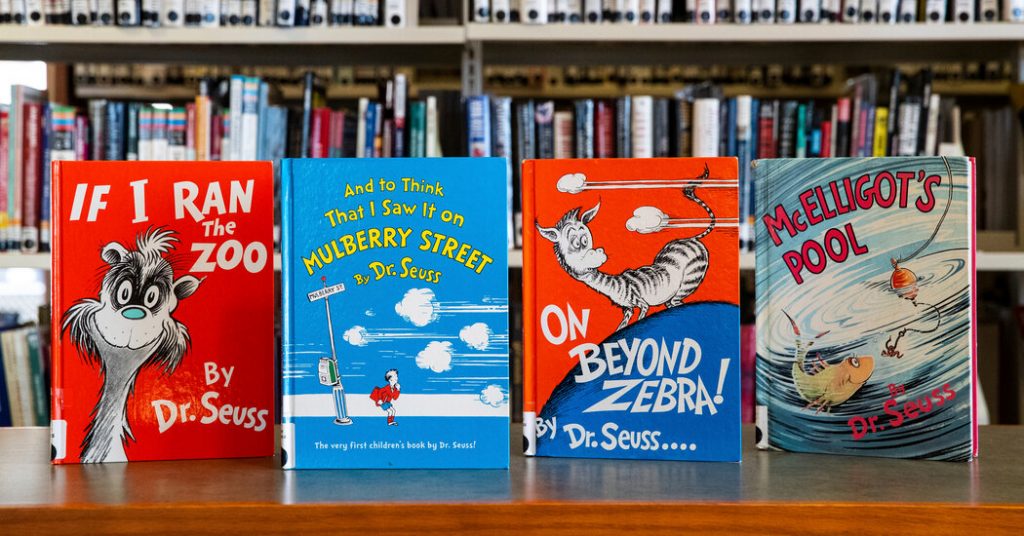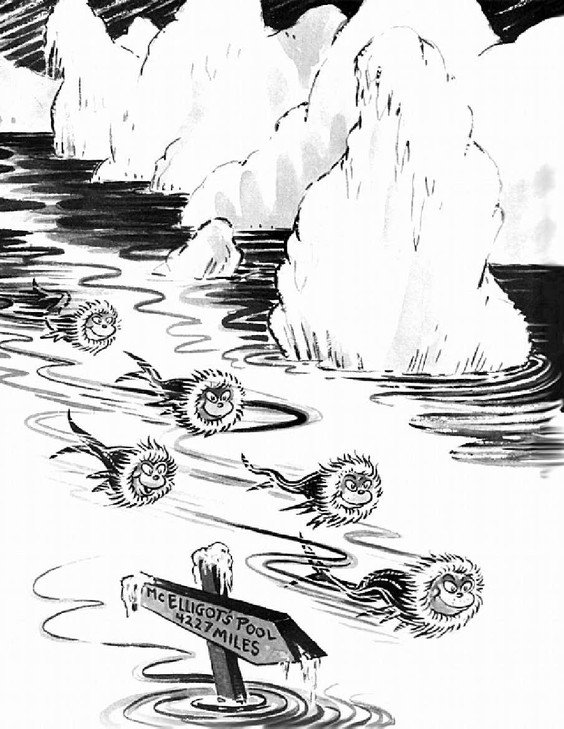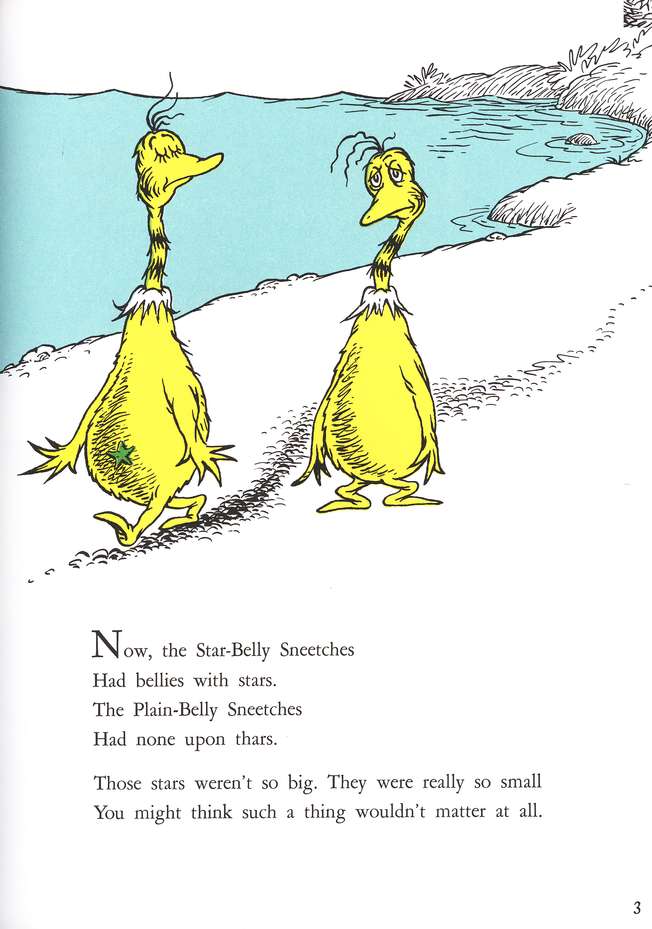Attempts to tear apart cultural artifacts and replace them with a culture imbuing a “higher” level of understanding - one that empowers leftist theorists – is evident in the Woke movement. One of the latest targets are the popular children’s author, Theodor Seuss Geisel - Dr. Seuss. The threat posed by Seuss in part may be the level of his success.
In America, Seuss became a cultural anchor point for hundreds of millions of children, and by tainting Seuss, his legacy, and people’s memories of him with accusations of racism and “harm,” that shared cultural anchor can be abolished. More room will be available to advance a new agenda, where texts are “decolonized” and written with an emphasis towards swaying adults and children into the type of thinking associated with Critical Theory, and anti-racism.
As of last week, six Dr. Seuss books - And to Think That I Saw It on Mulberry Street, If I Ran the Zoo, McElligot’s Pool, On Beyond Zebra!, Scrambled Eggs Super!, and The Cat’s Quizzer -will no longer be published over “hurtful and wrong imagery.” President Biden also left out mention of Dr. Seuss from Read Across America Day. Commentators have correctly stated that the decision to stop publishing the above six books came from Dr. Seuss’ estate, but they underplay the extent to which it has resulted from years-long activism against Seuss’, and especially the affiliation between Dr. Seuss and Read Across America Day, which was previously heavy with Seuss imagery since it takes place on Seuss’ birthday.
 Moreover, the targeted activism is only a small part of a bigger project by the entire woke movement to negate or abolish the cultural hegemony and rewrite it within their own imaginings. We can trace these types of methods back to Antonio Gramsci or cultural Marxism, where the target was changed from the economy associated with traditional Marxist theory onto culture and detaching people from their cultural anchors. This strategy was used by Mao and Lenin too. Mao, for example, referred to it as destroying the four olds – old ideas, old habits, old customs, and old ways of thinking – and used it via the Red guards during the Chinese Cultural revolution. Likewise, revolutionaries aimed to reset French society during the French Revolution. So, while it may seem small to go after, or stop publishing some Dr. Seuss books, it can be just a wedge to uproot some culture with the premise that children should not be exposed to it, and, if you taint six of his books, everything he did can be questioned.
Moreover, the targeted activism is only a small part of a bigger project by the entire woke movement to negate or abolish the cultural hegemony and rewrite it within their own imaginings. We can trace these types of methods back to Antonio Gramsci or cultural Marxism, where the target was changed from the economy associated with traditional Marxist theory onto culture and detaching people from their cultural anchors. This strategy was used by Mao and Lenin too. Mao, for example, referred to it as destroying the four olds – old ideas, old habits, old customs, and old ways of thinking – and used it via the Red guards during the Chinese Cultural revolution. Likewise, revolutionaries aimed to reset French society during the French Revolution. So, while it may seem small to go after, or stop publishing some Dr. Seuss books, it can be just a wedge to uproot some culture with the premise that children should not be exposed to it, and, if you taint six of his books, everything he did can be questioned.
Anti-racist Activism
The woke anti-racist activists today believe there is implicit racism everywhere, that it permeates society, institutions, and the society’s cultural artifacts to such an extent that people are socialized into a system of racism beyond their control – they become racist by being in a racist system. For these activists, it does not matter that Dr. Seuss was writing eighty years ago, that there is context to his work – and he was perhaps just a man of his times. For them, the sole issue is that kids might read Dr. Seuss and pick-up subtle racism, or read the “good” Dr. Seuss children’s books, then pick up some of his adult audience work that was political and did contain racist cartoons. Dr. Seuss’s body of children’s books is part of a cultural anchor that a huge number of American children are exposed to and grow up with, giving them a shared sense of identity and understanding, where they laugh and bond about Dr. Seuss's characters together. Activists think that a shared sense of culture needs to be destroyed and replaced with an anti-racist culture that empowers activism leaders.
Seuss Legacy
Dr. Seuss has sold over 650 million children’s books in seventeen languages and ninety-five countries, over 450 million of which have been sold since he died in 1991. According to Bill Dreyer, Collections Curator for the Art of Dr. Seuss' touring exhibitions, “Dr. Seuss is more popular now than he was during his lifetime,” and is still celebrated in American culture, homes, and classrooms as “the most popular children’s author in America. Herb Cheyette of Dr. Seuss Enterprises, too, said, “one out of every four children born in the United States receives as its first book a Dr. Seuss Book.”
Activism against Dr. Seuss books can be traced to academic research projects on diversity and youth literature, by researchers, like Ishizuka and Stephens, who say that before and during his career publishing children’s books, Seuss was known for publishing hundreds of racist political cartoons, comics, and advertisements for newspapers, magazines, companies, and the United States government.
On the other hand, Dr. Seuss scholars – of the non-activist variety - which researches his significance, maintains that even though his political works degraded Black, Indigenous, and people from other marginalized groups - Jewish people and Muslims, they differentiate this from his children’s books which actually “promote tolerance” and have “anti-racist” themes. For example, the Southern Poverty Law Center’s Teaching Tolerance program uses Seuss’ book - The Sneetches - in their anti-racist curriculum for children in Kindergarten through fifth grade to teach tolerance. While Horton Hears a Who! - is considered as “an allegory advocating equal treatment of all people.” Its line, “a person’s a person, no matter how small!” often quoted as a moral of tolerance.
Still, the anti-racist researchers decided to reconsider these findings through looking at how and to what extent non-White characters are depicted in Seuss’s children’s books.
 The “Eskimo Fish” featured in McElligot’s Pool.
The “Eskimo Fish” featured in McElligot’s Pool.
They studied fifty of fifty-nine Dr. Seuss children’s books, using various methods, and concluded that of the 2,240 human characters identified, only forty-five are characters of color - 2% of the total number of human characters. White supremacy was seen via Seuss predominantly using White characters - 98% or 2,195 of all the characters. They also worried that every character of color is male and that such characters are only ever presented in subservient or dehumanized roles. Women and girls of color are absent from Seuss's entire children’s book collection. Some books also feature animal or non-human characters that transmit Orientalist, anti-Black, and White supremacist messaging through allegories and symbolism. For them, Horton, the elephant in Horton Hears a Who! is not advocating equal treatment of all people, a more salient point is that Whos/Japanese are depicted as exotic, backward, uncivilized, dangerous in relation to Americans, needing saving.
As Horton commands the Mayor of the Whos: “You’ve got to prove now that you are really there!/... You are very small persons will not have to die/ If you make yourselves heard! So come on, now, and TRY!” According to the anti-racists, the problem here is that Horton “is the one who decides the Whos need to be saved in the first place, and he himself defines and dictates the actions needed to save them, including when he directs the Whos to prove their existence.” They go on to say that the Whos, having to prove their existence so they won’t be killed, is reminiscent of race relations, where people of color are forced to prove their lives “matter.” Or cases where people of color, especially Black people are victims, while White perpetrators of crimes against them are often not held accountable.
Likewise, they take issue with the book - The Sneetches – as a harbinger of tolerance and think it actually reinforces White supremacy by “upholding deficit-based, disempowered narratives of oppressed groups and promoting color-blindness.” It is worth considering their view here: “(oppressed) Plain-Belly Sneetches are depicted as “moping and doping” in their self-hatred and spend all their time, energy, and resources trying to be exactly like the dominant Star-Belly Sneetches.” This is a problematic and misguided way of perceiving oppressed groups, the anti-racist researchers say, “Oppressed communities fight to hang on to their own culture and identity and not have it colonized, erased, marginalized, or appropriated by the dominant culture. Oppressed people want to be free of oppression, but the Plain-Belly Sneetches never challenge their oppressor or the oppression itself. They never resist. The only action they take is to disregard their own identity and culture to take on the one of their oppressor.”
The book concludes with the Plain-Belly Sneetches and Star-Belly Sneetches getting confused as to who is oppressed and who is the oppressor, and they have “no choice” but to accept each other: Changing their stars every minute or two. “They kept running through/ Until neither the Plain nor the Star-Bellies knew/ Whether this one was that one… or that one was this one Or which one was what one… or what one was who… That day, all the Sneetches forgot about stars. And whether they had one or not, upon thars.” While Seuss scholars considered this tolerance, the anti-racists researchers think it promotes a false narrative that “not seeing difference” (color-blindness), is the solution to racism.
These themes are all the more problematic according to the anti-racist researchers, because children’s books can give impressions and transmit messages which can last the child’s whole life. So, when books center Whiteness, erase people of color and other oppressed groups, or present people of color in stereotypical, dehumanizing, or subordinate ways, they both ingrain and reinforce internalized racism and White supremacy. The lack of children’s books featuring people of color will therefore deny children of color an important source of positive racial identity development.
While more books featuring diverse characters would be welcome, it is also true that children can read more than one book, and many of the characters in Seuss books are not even people, the Grinch and Sneetches are not people, Horton is an elephant, and the Who’s are so small can they be people? They are allegories and not as relevant as the anti-racists want to make them out to be. There is no evidence to suggest Seuss books are brainwashing children to reproduce the same problems in society as a whole.
 In making their announcement regarding ceasing publication of the six Seuss books, Seuss Enterprises acknowledged “working with the panel of experts, including educators,” who could conceivably be the same activist researchers mentioned here. Indeed, in their work, Ishizuka and Stephens admit that in 2017 they successfully lobbied, through corralling teachers, schools, and educators to put pressure on the National Education Association’s (NEA) Read Across America (RAA) Advisory Committee. The NEA is an important body because it is responsible for the nation’s Read Across America Day – which has over 45 million annual participants. The NEA then decided to use the 2018 celebration taking place on Dr. Seuss's birthday to promote anti-racist diverse books by authors of color, instead of Dr. Seuss's children’s books and the author himself as it had done previously. The NEA then said it would start transitioning away from Dr. Seuss, change RAA’s theme to “Celebrating a Nation of Diverse Readers,” and use the event as an opportunity to promote social justice removing the dominance of Dr. Seuss books from their annual Read Across America Resource Calendar.
In making their announcement regarding ceasing publication of the six Seuss books, Seuss Enterprises acknowledged “working with the panel of experts, including educators,” who could conceivably be the same activist researchers mentioned here. Indeed, in their work, Ishizuka and Stephens admit that in 2017 they successfully lobbied, through corralling teachers, schools, and educators to put pressure on the National Education Association’s (NEA) Read Across America (RAA) Advisory Committee. The NEA is an important body because it is responsible for the nation’s Read Across America Day – which has over 45 million annual participants. The NEA then decided to use the 2018 celebration taking place on Dr. Seuss's birthday to promote anti-racist diverse books by authors of color, instead of Dr. Seuss's children’s books and the author himself as it had done previously. The NEA then said it would start transitioning away from Dr. Seuss, change RAA’s theme to “Celebrating a Nation of Diverse Readers,” and use the event as an opportunity to promote social justice removing the dominance of Dr. Seuss books from their annual Read Across America Resource Calendar.
Activists want to tear down the cultural legacy of Seuss, and if part of the culture is torn down, there is more room for a systemic change that changes everything, so who we are and how we relate to one and another can be put into the activists' hands.



